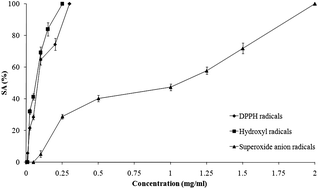Antiradical, antimicrobial and cytotoxic activities of commercial beetroot pomace
Abstract
The by-product of

* Corresponding authors
a
Faculty of Technology, University of Novi Sad, Bulevar Cara Lazara 1, Novi Sad, Serbia
E-mail:
jvulic@uns.ac.rs
Fax: +381 21 450 413
Tel: +381 21 485 3652
b Faculty of Medicine, University of Novi Sad, Hajduk Veljkova 3, Novi Sad, Serbia
The by-product of

 Please wait while we load your content...
Something went wrong. Try again?
Please wait while we load your content...
Something went wrong. Try again?
J. J. Vulić, T. N. Ćebović, V. M. Čanadanović, G. S. Ćetković, S. M. Djilas, J. M. Čanadanović-Brunet, A. S. Velićanski, D. D. Cvetković and V. T. Tumbas, Food Funct., 2013, 4, 713 DOI: 10.1039/C3FO30315B
To request permission to reproduce material from this article, please go to the Copyright Clearance Center request page.
If you are an author contributing to an RSC publication, you do not need to request permission provided correct acknowledgement is given.
If you are the author of this article, you do not need to request permission to reproduce figures and diagrams provided correct acknowledgement is given. If you want to reproduce the whole article in a third-party publication (excluding your thesis/dissertation for which permission is not required) please go to the Copyright Clearance Center request page.
Read more about how to correctly acknowledge RSC content.
 Fetching data from CrossRef.
Fetching data from CrossRef.
This may take some time to load.
Loading related content
